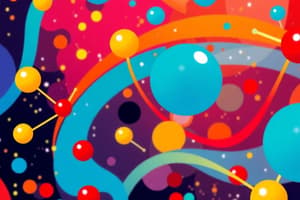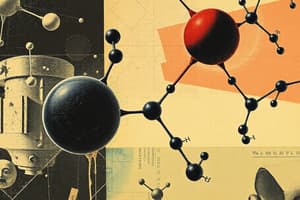Podcast
Questions and Answers
In a well-designed experiment to test a scientific theory, what is the MOST crucial outcome that determines the theory's validity?
In a well-designed experiment to test a scientific theory, what is the MOST crucial outcome that determines the theory's validity?
- The experiment utilizes the latest technology and equipment.
- The experimental findings are consistent with the predictions of the theory. (correct)
- The experiment is visually appealing and easy to understand.
- The experimental procedure is complex and requires advanced mathematical calculations.
Why is quantification, involving measurement, considered 'one of the most important tools in science'?
Why is quantification, involving measurement, considered 'one of the most important tools in science'?
- It makes research papers longer and more credible.
- It allows for aesthetic judgments about data.
- It eliminates the need for qualitative observations.
- It enables scientists to express differences precisely. (correct)
What is the MOST significant factor that elevates a scientific theory beyond a 'mere speculation'?
What is the MOST significant factor that elevates a scientific theory beyond a 'mere speculation'?
- Its extensive support from experimental evidence. (correct)
- Its intuitive appeal and alignment with common sense.
- Its longevity and historical significance.
- Its complexity and mathematical sophistication.
Imagine a scientist conducts an experiment that directly contradicts a long-standing scientific law. According to the principles of the scientific method, what should the scientist do?
Imagine a scientist conducts an experiment that directly contradicts a long-standing scientific law. According to the principles of the scientific method, what should the scientist do?
The concept that 'matter is conserved in chemical reactions' suggests which of the following MUST be true in a closed system?
The concept that 'matter is conserved in chemical reactions' suggests which of the following MUST be true in a closed system?
Which of the following best describes the primary focus of chemistry as a scientific discipline?
Which of the following best describes the primary focus of chemistry as a scientific discipline?
Why is it important to recognize that chemicals are not just dangerous poisons or pollutants?
Why is it important to recognize that chemicals are not just dangerous poisons or pollutants?
In the context of chemistry, what is the significance of chemical bonds?
In the context of chemistry, what is the significance of chemical bonds?
Water molecules are bent, and consist of one oxygen and two hydrogen atoms. How does this shape influence water's properties at room temperature?
Water molecules are bent, and consist of one oxygen and two hydrogen atoms. How does this shape influence water's properties at room temperature?
What distinguishes the scientific method from ancient Greek philosophies and medieval applications?
What distinguishes the scientific method from ancient Greek philosophies and medieval applications?
A chemist observes that a certain gas occupies a larger volume when heated. What is the next step the chemist should take, according to the scientific method?
A chemist observes that a certain gas occupies a larger volume when heated. What is the next step the chemist should take, according to the scientific method?
What role do experiments play in the scientific method?
What role do experiments play in the scientific method?
How are hypotheses refined within the scientific method?
How are hypotheses refined within the scientific method?
Which of the following best describes the role of experimentation in the scientific method?
Which of the following best describes the role of experimentation in the scientific method?
Antoine Lavoisier's experiments with combustion in closed containers led him to what significant conclusion?
Antoine Lavoisier's experiments with combustion in closed containers led him to what significant conclusion?
A scientist observes that a certain gas occupies a smaller volume when the pressure is increased. They propose the hypothesis that the volume of a gas is inversely proportional to the pressure applied. What is the next step in the scientific method?
A scientist observes that a certain gas occupies a smaller volume when the pressure is increased. They propose the hypothesis that the volume of a gas is inversely proportional to the pressure applied. What is the next step in the scientific method?
How does a scientific law differ from a scientific theory?
How does a scientific law differ from a scientific theory?
Which of the following statements best describes a 'falsifiable' hypothesis?
Which of the following statements best describes a 'falsifiable' hypothesis?
A researcher performs an experiment multiple times but obtains results that contradict their initial hypothesis. According to the scientific method, what should the researcher do?
A researcher performs an experiment multiple times but obtains results that contradict their initial hypothesis. According to the scientific method, what should the researcher do?
In the context of the scientific method, what is the primary purpose of making observations?
In the context of the scientific method, what is the primary purpose of making observations?
A well-established scientific theory can do which of the following?
A well-established scientific theory can do which of the following?
Flashcards
Chemistry
Chemistry
The science of matter and its properties, studied at the atomic and molecular level.
Atoms and Molecules
Atoms and Molecules
Tiny particles that make up all common matter; they bind together to form molecules.
Chemical Bonds
Chemical Bonds
The attachments that hold atoms together to form molecules.
Scientific Method
Scientific Method
Signup and view all the flashcards
Observations
Observations
Signup and view all the flashcards
Hypothesis
Hypothesis
Signup and view all the flashcards
Scientific Laws
Scientific Laws
Signup and view all the flashcards
Theories
Theories
Signup and view all the flashcards
Conservation of Mass
Conservation of Mass
Signup and view all the flashcards
Revising Scientific Theories
Revising Scientific Theories
Signup and view all the flashcards
Scientific Theory
Scientific Theory
Signup and view all the flashcards
Atomic Theory
Atomic Theory
Signup and view all the flashcards
Quantification in Science
Quantification in Science
Signup and view all the flashcards
Combustion
Combustion
Signup and view all the flashcards
Mass
Mass
Signup and view all the flashcards
Experiments
Experiments
Signup and view all the flashcards
Law of Conservation of Mass
Law of Conservation of Mass
Signup and view all the flashcards
Study Notes
The Chemical World
- Chemistry seeks to comprehend the behavior of matter by studying atoms and molecules.
- Chemicals are the building blocks of virtually everything.
Chemicals
- Chemicals aren't just dangerous poisons or pollutants, this is often a misconception
- Chemicals are present in the air, water, toothpaste, Tylenol, and toilet paper.
Atoms and Molecules in Matter
- Atoms are exceptionally minute and collectively form all matter.
- Atoms are bound together creating molecules.
- Chemical bonds connect atoms.
Molecular Models
- Atoms are represented by colored balls linked by sticks in the ball-and-stick model.
- Red represents Oxygen
- White represents Hydrogen
- Black represents Carbon
- Blue represents Nitrogen
- Yellow represents Sulfur
Water molecule
- Water molecules contain one oxygen and two hydrogen atoms that create a bent shape.
- These characteristics makes water a liquid at room temperature.
The Scientific Method
- Chemists use the scientific method, which emphasizes observation and experimentation to understand the world.
- Knowledge is obtained through senses.
- This method stands in contrast to ancient Greek philosophies and medieval applications.
- Those applications were based on reason to produce knowledge.
Observations
- Observations involve measuring or observing some aspect of nature.
- Some may require sensitive instrumentation beyond what can be seen with the naked eye.
Hypotheses
- Hypotheses are tentative interpretations of the observations.
Laws
- Laws summarize the results of a large number of observations.
Theories
- Theories are models that explain and give the underlying causes for observations and laws.
Experiments
- Hypotheses, laws, and theories must be tested and validated by experiment.
- Hypotheses that are not confirmed must be revised and tested through experimentation.
Antoine Lavoisier
- Antoine Lavoisier (1743–1794), a French chemist, made an observation about the physical world regarding combustion.
- Lavoisier measured mass in the process of combustion, which is burning.
- Mass measures the quantity of matter within an object.
- Lavoisier burned substances in closed containers while measuring the mass before and after burning.
- He observed no change in mass during combustion.
Hypothesis Testing
- Observations lead scientists to create hypotheses, which are tentative interpretations or explanations.
- A good hypothesis is falsifiable.
- Hypotheses are tested through experiments, which are controlled observations designed to validate or invalidate them.
- The results of experiments confirm or disprove hypotheses.
- Hypotheses may need modification or replacement based on the results of experiments.
- New or revised hypotheses require further testing through experimentation.
Law of Conservation of Mass
- A number of similar observations can lead to a scientific law.
- A scientific law is a statement that synthesizes past observations and predicts future ones.
- Lavoisier developed the law of conservation of mass.
- In a chemical reaction, matter is neither created nor destroyed, according to the law of conservation of mass.
The Scientific Method: Scientific Theory
- Well-established hypotheses can form the basis for a scientific theory.
- Theories provide a deeper description for observations and laws.
- Theories also model the way nature is.
- Theories can often predict behavior that goes beyond the observations and laws on which they are founded.
The Scientific Method: Experiments
- If a law, hypothesis, or theory is inconsistent with experimental findings, then revisions are required.
- Good theories remain and are consistent with experiments.
Established Theories
- Well-supported theories are the most powerful pieces of scientific knowledge.
- "That is just a theory," should not be said, as if they were mere speculations.
- Well-tested theories are as close to truth as science can deliver.
The Scientific Method: Atomic Theory
- The idea that matter is made of atoms is a 200-year-old theory.
- Modern technology provides images of atoms themselves to further prove this.
Chemistry Requires Calculation
- Quantification is measurement as part of observation.
- Quantification allows to specify the difference precisely.
- For example, two samples of water may feel equally hot, but one may measure 40°C, while the other measures 44°C.
Studying That Suits You
Use AI to generate personalized quizzes and flashcards to suit your learning preferences.




